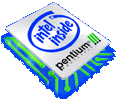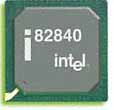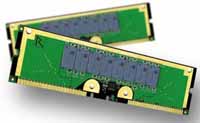Buyer's Guide: High-End Systems - December 2000
by Mike Andrawes on December 24, 2000 2:52 PM EST- Posted in
- Guides
Dream System
Not having to
worry about price is a luxury few people have, but it never hurts to dream up
what you would buy in such a situation. Or maybe you’ve just won the lottery.
Perhaps it’s not even your own money involved thanks to a grant or simply an
ungodly budget. Whether dreaming or actually looking to buy, putting together
the dream professional system can be a tricky, but fun, proposition. Below are
our picks for such a system.
 CPU
– Dual Pentium III 933 - $375 x 2
CPU
– Dual Pentium III 933 - $375 x 2
The CPU is probably
the most critical, as well as the most controversial, component of any system.
The old AMD versus Intel battle wages on stronger than ever before with the
Athlon and Pentium III. It’s a touchy subject among many die-hard fans of each
processor type, but for the professional dream system, we have to go with an
Intel CPU for one key reason – SMP. While the benefits of SMP vary greatly
depending on the applications in use, professional apps are generally the ones
best able to take advantage of SMP. Recently, games have begun to take some
advantage of SMP, starting with Quake 3: Arena. Now that Windows 2000 supports
SMP and DirectX 7 (and now DirectX 8), we should begin seeing more games that
are capable of using SMP.
While Pentium III’s up to 1.13GHz have already been announced by Intel, and then quickly recalled, don’t even waste your time trying to get a hold of one at this point. We also decided to pass on the new Pentium III Xeon’s since the only difference between them and the standard model is the Slot-2 interface that it uses and the higher price.
The Pentium 4 has finally arrived, but currently does not look to be a very good purchase at this point in time due to poor performance in most applications and its high price. The Pentium 4 might still have a chance to make the dream system if it weren't for the fact that it doesn't support SMP in any form with the Willamete core. SMP support on the Pentium 4 will have to wait until late next year when the Northwood core is released.
The fastest readily available Pentium III is the 933 MHz model, so that’s what we’re going with. They’re currently available for around $375. Pentium III 1 GHz models ae no longer impossible to find, but they're still not everywhere.
For more information on all Pentium III's, read our Pentium III 1GHz Review.
 Motherboard
– Intel OR840 - $300
Motherboard
– Intel OR840 - $300
Our choice of dual Pentium III’s narrowed down our motherboard options very
quickly. While the Microstar 694D Pro has finally shown us the potential of
VIA Apollo Pro 133A chipset in SMP mode, the
i840 with RDRAM is still able to maintain a slight performance lead. Those looking
to save quite a bit of money on their motherboard and memory should definitely
take a look at the 694D Pro, but since this is a dream system, we'll go with
the slightly faster i840 despite the large price premium.
It should be noted that while we've seen the i440BX overclocked to a 133 MHz FSB successfully, only a few dual i440BX boards are even Coppermine capable, much less able to run at 133 MHz FSB with two CPU's in place. The option is there if you don't mind an overclocked system, but we'll stick to the Apollo Pro 133A and i840/i820 for more reliable dual operation. It should also be noted that the i815 is not an SMP capable chipset, as Intel has aimed it squarely at the value market.
ServerWorks has a couple of PC133 SDRAM chipset entries in the dual processor Pentium III market, but for now, those solutions remain somewhat unproven. Hopefully, we'll be able to get a sample into the AnandTech labs for thorough testing shortly. Be warned, however, that the semi-reasonably priced ServerWorks Server Set III LE does not support AGP in any form. You'll have to get the considerably more expensive Server Set III WS or HE to get AGP support.
Of all the i840 boards out there, the OR840 from Intel is the only one that fits our requirements and is relatively easy to get a hold of. It also throws in an optional onboard Intel 82559 ethernet controller and an AGP Pro 50 slot. There is also optional AC97 audio onboard, which may be sufficient if you don’t really use sound that much in your work. But why cripple a system like this with host-based audio? We’ll disable it and add a true hardware based PCI card later.
Unfortunately, the OR840 choice means overclocking is out for now. We've been hoping to revise the motherboard selection as more i840 boards became available, but it seems that the i840 has been orphaned by motherboard manufacturers.
 Memory
– 512MB PC800 RDRAM (2 x 256MB RIMM’s) - $1000
Memory
– 512MB PC800 RDRAM (2 x 256MB RIMM’s) - $1000
Not having to
worry about cost is a beautiful thing and really comes in handy when choosing
a memory type, especially since you can easily spend more on memory than most
people spend on their whole system. As such, we had no hesitation in picking
RDRAM for our dream system even though they cost $500 for a 256MB stick. RDRAM
prices are still dropping, but not nearly quickly enough for the majority of
users.
Since we’ve got two RAMBUS channels on our OR840 motherboard, we need to install our RIMM’s in pairs. Even without that requirement, what dream professional system would be complete with 512MB of RAM total? Since the largest RIMM readily available on the market today is 256MB, we need 2 sticks in order to get a total of 512MB RAM.










0 Comments
View All Comments